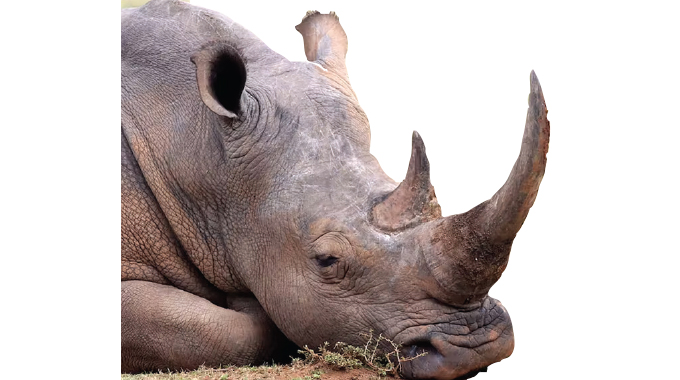Big no to radioactive material injected rhino

Emmanuel Koro, Opinion
University of Witwatersrand Professor James Larkin offers no apologies that his proposed experiment to inject live rhino’s horns with radioactive materials to discourage poaching may destroy the legal rhino horn trade, including rhino ranchers’ business.
Concerned conservationists say this experiment is a good example of using extreme solutions instead of simple and practical ones to manage problems.
Rhino poaching, in recent years, has been kept in reasonable check by diligent guards and strong fencing. On the other hand, exposure to radioactivity can cause nausea, vomiting, hair loss, diarrhoea, central nervous system damage, and death. It also causes DNA damage and raises the risk of cancer, particularly in young children and foetuses.
However, Prof Larkin, Witwatersrand University Director of the Radiation and Health Physics Unit, said his Rhisotope Project aims to inject the rhino horn with small quantities of radioactive materials that he believes are “harmless.”
“Putting radioactive material into the rhino horn is the idea of the project (Rhisotope) to devalue the horn and make people not get interested in it,” said Prof Larkin.
Employed by the university since 1999, Prof Larkin said he was not forcing people to accept the injection of the live rhinos’ horns with radioactive material.
“Good thing,” noted the managing Director of the Los Angeles-based Ivory Education Institute, Mr Godfrey Harris. He welcomed the need “not to force people” because Prof Larkin “has no mandate nor ability to force anybody to accept any element of this nutty scheme.”
“It’s entirely the decision of the owners of the rhino,” said Prof Larkin. “It’s entirely up to them not to accept but they must face the consequences of rhino poaching if they don’t accept it.”
Mr Harris said the rhino ranchers long ago accepted the rhino poaching challenge, well before Prof Larkin found his way onto the field of play to address the problem.

Professor James Larkin
“The rhino ranchers have built large, growing and vibrant white rhino herds despite the rhino poaching threats,” said Mr Harris.
Prof Larkin noted that the likes of South Africa-based John Hume (the world’s biggest white rhino producer) “created a catastrophic business model” by raising a large herd whose horns they might never trade in the future.
Meanwhile, the Chairman of South Africa’s Private Rhino Owners Association (PROA), Mr Pelham Jones said, “We’re deeply concerned that the project, while well intended, is in conflict with our rights as owners to sustainable utilisation as is entrenched in the Constitution.”
“Trade in rhino horn will generate much needed conservation revenue which in the long term will assist rural communities with job creation and transformation,” said Mr Jones. “The Rhisotope Project is in total conflict with this proposal as the horns will lose all commercial value.”
Reacting to Prof Larkin’s proposed experiment, the Chief Executive Officer of South Africa-based True Green Alliance, Mr Ron Thomson said, “I’m absolutely aghast at the lack of perspicacity on the part of Prof’s Larkin’s understanding about the wildlife management needs in Africa today.
“His idea panders to the animal rights ideology which is dominated by one word “PROHIBITION”. He wants to STOP trade.

Private Rhino Owners Association
“We want to legalise trade. I would suggest that Prof Larkin re-educates himself starting with learning the fundamentals that led us to where we are today.”
Prof Larkin was recently quoted in the media as saying that the Rhisotope Project is receiving “overwhelming support.” Yet he declined to disclose the names of organisations and governments that are supporting him. Mr Harris noted that if Prof Larkin had the support that he claims, he would flaunt it or at least identify any agency, “other than himself who believes this is a viable scheme.”
Mr Jones added: “We’ve seen a similar concept to infuse a horn with poison. But research showed that it is simply not possible to do this due to the density of rhino horn. Secondly, this action didn’t prevent poachers from killing rhino that had been marked as having been treated with poison,” said Mr Jones.
Despite these statements, Prof Larkin claims to be proceeding with the Rhisotope Project experiment.
“We’re at the early stages of discussion with many stakeholders,” he said. “It (support for the Rhisotope Project) is coming from all sorts of different places. (Again, unidentified.) I’m not subscribing to your agenda that Europeans are dictating to Africa. I’m an African (but of European heritage) born in Kenya.”
One of Zimbabwe’s top conservationists and former Director-General of Zimbabwe Parks and Wildlife Management Authority, Dr Morris Mtsambiwa, said that he would not welcome the Rhisotope Project to Zimbabwe.
“Personally, I think one day Zimbabwe should be able to trade in its rhino horns and therefore injecting radioactive material is not good,” said Dr Mtsambiwa.
“I wouldn’t encourage Zimbabwe to support such a proposal. Sounds dangerous already! Trade in rhino horns has to take place sustainably if we’re to benefit from rhino conservation otherwise there would be no incentive to conserve rhinos.”
Kenya, Prof Larkin’s home country, has been captured by the animal rights groups fundraising industry — an industry that now raises more than US$600 million annually from Western sources to sponsor restrictive policies on wild species trade in Africa. The animal rights groups believe that humankind should not use wildlife for any activity, including trade. Wildlife, they believe, should remain free of human interference, be beautiful to see and serve photographic tourism. They, of course, ignore the fact that uncontrolled growth of wild animals has caused the devastation of such treasures as Kruger National Park, nearly stripped bare in some areas by hungry elephants looking for food and water.
Now we have Kenya-born Professor Larkin attempting to extend the anti-use culture of his native land by introducing the injection of live rhino’s horns with radioactive materials to scare away the current markets from legally buying rhino horn for personal needs which is allowed by the UN Convention on International Trade in Endangered Species of Fauna and Flora (CITES.)
Concerned conservationists have said that it should be pointed out that a rhino’s horn is a renewable resource that regrows, very much like a human’s fingernail, and is harvestable every two years or so, without needing to kill the rhino. It can be trimmed with no pain and no harm to the animal. It is widely feared, however, that the Rhisotope initiative could destroy the potential to ever trade and benefit from rhino horn for conservation and development purposes in Africa.
“Injecting radioactive material into our rhinos would make the rhino, as a species, inimical (without any benefit to humans),” said Mr Thomson. “It will negate the use of ‘legal trade’ (to) ‘save’ our rhinos into posterity by way of making the species valuable to mankind.”
λ About the writer: Emmanuel Koro is a Johannesburg-based independent environmental journalist who writes extensively on environment and development issues in Africa.











Comments